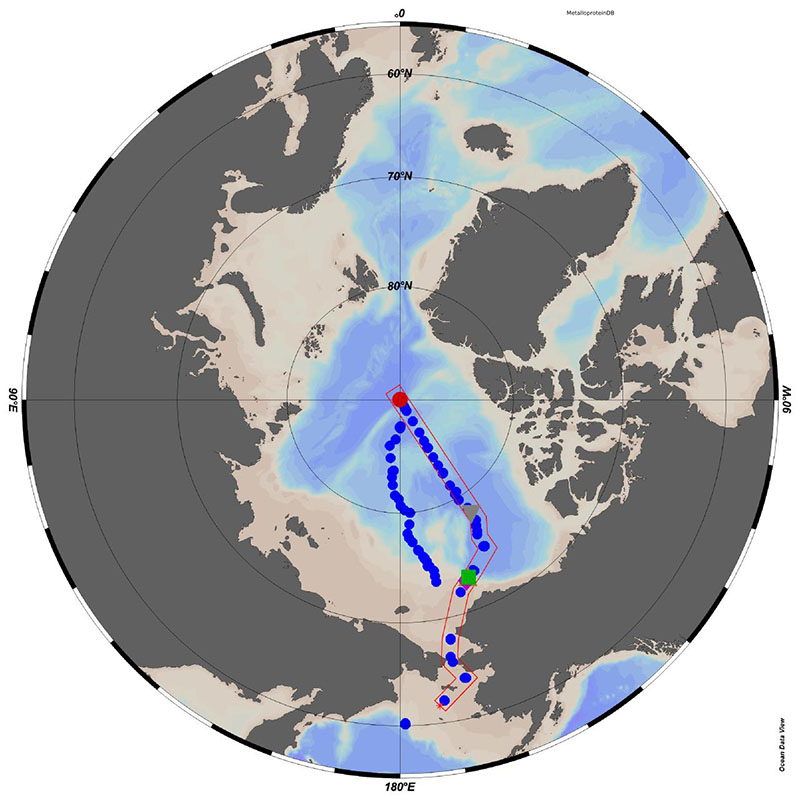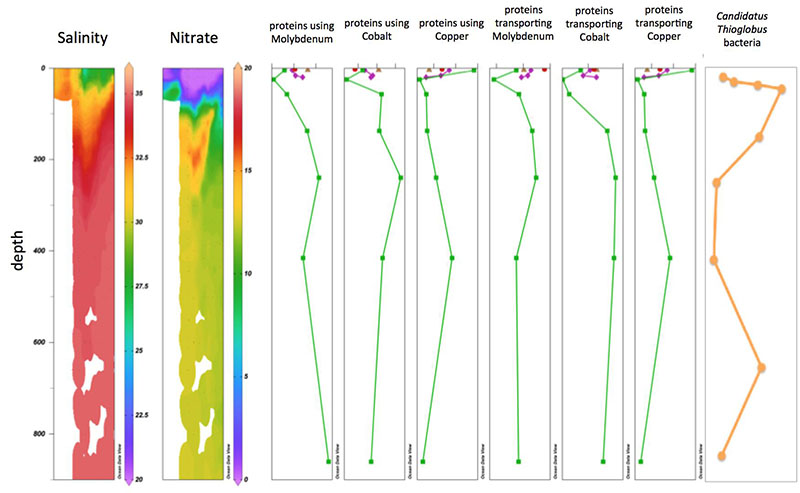
By Eric Collins, University of Alaska Fairbanks
When we think about mapping microbes, we can consider any number of boundaries within which to do the mapping. We’ve previously mapped microbes spatially and taxonomically, but another important orientation in the ocean is vertically, by depth.
The ocean has many layers and these layers often do not interact with each other, meaning that some layers can become isolated for hundreds of years or more. As they become isolated, their physical, chemical, and biological properties change and we can track different water masses by looking at these changes. One interesting property we can see within these water masses is their metal content.
In small doses, metals are essential in biology as substrates in energy-generating reactions and as cofactors in proteins, many of which require metals to function (these are called metalloproteins). At higher concentrations, metals can be harmful to plankton and other life.
The distribution and concentration of biologically active metals in the Arctic Ocean—and their influence and modification by microbes—has remained unknown until recently. During the 2015 U.S. GEOTRACES Arctic research cruise to the North Pole aboard the U.S. Coast Guard Cutter Healy, samples were collected for measuring microbial functional diversity and the abundance of major and trace elements (including cadmium, cobalt, copper, iron, manganese, molybdenum, nickel, phosphorous, vanadium, and zinc). Samples were collected from sea ice and surface seawater down to a depth of 3,900 meters (Figure 1).

Figure 1. Map of samples collected during the Arctic GEOTRACES Cruise in 2015. Image courtesy of the Mapping the Uncharted Diversity of Arctic Marine Microbes expedition. Download larger version (jpg, 395 KB).
To look at changes in metal usage by microorganisms across the central Arctic Ocean, we designed an automated pipeline to compare DNA sequences against databases of known metal-containing proteins. The goal is to map out how the microbes in different layers in the Arctic Ocean influence the metal content in those layers and vice versa. This will help chemical oceanographers to better track these water masses and will help biological oceanographers better understand why certain marine microbes prosper in some layers and not others.

Figure 2. Arctic Ocean water layers overlaid on a bathymetric map of the eastern Arctic basin. Image courtesy of the Mapping the Uncharted Diversity of Arctic Marine Microbes expedition. Download larger version (jpg, 306 KB).
The Arctic Ocean has several water layers coming from different sources (Figure 2). The organization of these layers is determined by their density: in general in the ocean, cold, salty water is on the bottom and warm, fresh water is on the top.
In the Arctic, the very top of the ocean is covered with a layer of sea ice that can be up to five meters thick. When the sea ice forms in the winter, it produces a layer of very cold, very salty water that sinks and can mix with the layers below on the way down. When sea ice and snow melt in the summer, a layer of very fresh meltwater and river runoff is produced that is depleted in nutrients. Below the meltwater is the halocline layer, which stretches down to about 250 meters and is where the salinity changes the most. Below the halocline layer is the Atlantic layer, which flows into the Arctic via Fram Strait, near Greenland. The Atlantic layer is much warmer and saltier than the halocline layers above, and is a major source of heat contributing to the melting of Arctic sea ice. It is also quite old, having been separated from the Atlantic Ocean for hundreds or even thousands of years. Finally, from about 1,000 meters to the bottom of the water column is the deep water layer, produced and held in the Arctic basin by shallower sills that prevent it from escaping to the Atlantic Ocean.

Figure 3. Metalloprotein gene abundance with depth in the Arctic Ocean. Salinity (in Practical Salinity Units) and Nitrate (in micromoles per liter) are shown to provide environmental context. Image courtesy of the Mapping the Uncharted Diversity of Arctic Marine Microbes expedition. Download larger version (jpg, 391 KB).
In the water column, the abundance of most metalloprotein genes exhibited vertical structure, often including a peak in the surface with a general decline in relative abundance to depth (Figure 3). Many metalloprotein profiles also showed an additional peak in the subsurface, generally between 250 and 500 meters. These proteins were often involved in using or transporting arsenic, cadmium, cobalt, copper, iron, molybdenium, nickel, and selenium. These waters were often dominated by sequences with best hits to Candidatus Thioglobus, a genus of sulfur-oxidizing Gammaproteobacteria that produces biomass from carbon dioxide in a process called chemoautotrophy. We are currently investigating the metalloprotein content (or lack thereof) of Candidatus Thioglobus to determine the impact of these bacteria on metal transformations in the Arctic Ocean.
Click here (pdf, 3.1 MB) to see a poster about these findings.